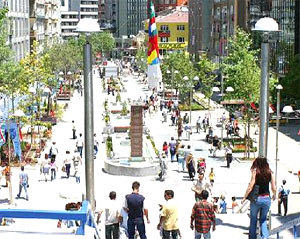Cuba marks anniversary of the revolution
 Havana - Hawkers with their mobile snack bars are enjoying good business at the moment in the pedestrian zone in San Rafael in Cuba's capital Havana. A bread roll with pork (Lechon), a plastic cup of oyster cocktail (Ostion) and a portion of ice cream cost together five peso.
Havana - Hawkers with their mobile snack bars are enjoying good business at the moment in the pedestrian zone in San Rafael in Cuba's capital Havana. A bread roll with pork (Lechon), a plastic cup of oyster cocktail (Ostion) and a portion of ice cream cost together five peso.
Many Cubans are taking up the offer but standing close by is a couple from Europe. Five convertible pesos (CUC), one of two official currencies in use in Cuba, is the equivalent of 5.40 dollars - a not inconsiderable sum of money. The couple are not used to the system of dual currencies that operates on the island.
Jim from Chicago, however, has no qualms. The programmer, who according to US laws should not even be in socialist Cuba, knows that Cuba's "moneda nacional" (MN) is the "soft" peso that ordinary Cubans earn.
Foreigners usually don't have any but they are available in the banks. Five MN equals about 20 US cents - who could complain about that?
On the promenade in Havana Vieja, the old district of the city and a World Heritage Site, Cubans and tourists from all over the world mingle.
A camera shutter clicks. A mother and daughter are having a picture taken of themselves in front of shop. In the window hangs an image of Cuba's long-time leader Fidel Castro with the number 50.
Over the course of this year Cuba is celebrating the 50th anniversary of the revolution. Che Guevara's image can be seen on walls in Havana, Cienfuegos, Trinidad and Santiago. The President of Cuba, Raul Castro, who is also Fidel's brother, is taking a low profile during the celebrations.
Jim from the US is having a drink in a corner bar in central Havana. The plaster is peeling from the walls of the district's historic houses and the paint has faded.
The toilet no longer flushes but to compensate for that beer costs just six MN. For locals who don't have relatives in Miami and who don't work in the tourist industry that is a lot of money.
Jim explains how he along with thousands of his compatriots ignore the US embargo and travel every year to Cuba via third countries such as Mexico. "The authorities in Cuba don't put a stamp in my passport and I won't be taking any cigars or rum home with me," he says.
Hopefully Jim's covert trips will soon be a thing of the past if most US citizens get their way. In April US President Barack Obama relaxed rules on travel to Cuba. Exiled Cubans can now visit their home country without limitations and transfer money back to relatives.
Three powerful hurricanes hit the island in autumn last year and caused immense damage. Tourism was also affected but in centrally controlled Cuba, evacuations and reconstruction work were carried out in an efficient manner thanks to the mobilisation of students and farm workers.
The countless propaganda posters that adorn beeches, sugar cane plantations and beef cattle pens provide a decorative image for many holiday snaps.
Having one in the background is a good way of telling friends back home that Cuba's struggle is eternal (siempre) and that dictatorship and attacks from abroad will receive the clear answer of more revolution (mas revolucion). (dpa)